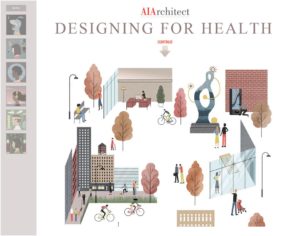- June 30, 2015
- 0 Comments
- In Accessible Design and Construction
- By
What is the relationship between accessible design and designing for health and wellness?
As Lead on Accessibility for the AIA Committee on Design + Wellbeing and Senior Accessibility Consultant for Steven Winter Associates, this is a question I am often asked. The answer is threefold:
1) The six AIA Principles on  Designing for Health directly impact people with disabilities. For example, to help people with disabilities safely navigate the built environment and engage with their community, we must promote Safety and Social Connectedness; by addressing Environmental Quality we can mitigate the onset of certain disabilities, such as asthma, that can arise from polluted surroundings; the effective design of Sensory Environments and Access to Natural Systems can reduce stress and anxiety to enhance physical and mental health; and Physical Activity can be critical to physical therapy and rehabilitation for people with disabilities.
Designing for Health directly impact people with disabilities. For example, to help people with disabilities safely navigate the built environment and engage with their community, we must promote Safety and Social Connectedness; by addressing Environmental Quality we can mitigate the onset of certain disabilities, such as asthma, that can arise from polluted surroundings; the effective design of Sensory Environments and Access to Natural Systems can reduce stress and anxiety to enhance physical and mental health; and Physical Activity can be critical to physical therapy and rehabilitation for people with disabilities.
2) Because accessibility and healthy design initiatives both strive to alter the way we define the built environment, proponents of health and wellness design can benefit from lessons learned by those who championed accessible design years ago. Key takeaways that were critical to the success of the accessibility initiative could be shared, such as how to advocate for federal legislation implementing design standards; how to receive buy-in from the market; and how to thoughtfully engage industry leaders.
3) With many health and wellness design initiatives in their infancy, now is the time to ensure that people with disabilities are incorporated into the standards. Physical activity, as one example, is often lauded as the pinnacle of healthy design; however, standards from various health design guidelines, such as staircases or incentives for walking or biking to work, may not be available to people with disabilities. Products such as accessible exercise equipment and track lanes wide enough to accommodate wheelchairs can and should be elements of healthy buildings.
Along with the Committee for Design + Wellbeing, I look forward to continuing the conversation between all of us with vested interest in improving the built environment for healthy building occupants.
